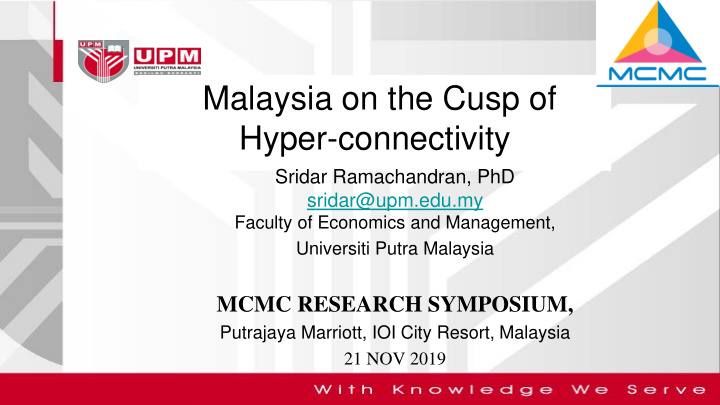



Malaysia on the Cusp of Hyper-connectivity Sridar Ramachandran, PhD sridar@upm.edu.my Faculty of Economics and Management, Universiti Putra Malaysia MCMC RESEARCH SYMPOSIUM, Putrajaya Marriott, IOI City Resort, Malaysia 21 NOV 2019
TRACK 2 – LAW AND TECHNOLOGY Session 1: Design and Accountability: Appraising Communications Technology through the Lens of Ethics, Society and Values (Past, present and future)
Social inclusion and overcoming the digital divide issue among rural indigenous communities in Sabah
AP Dr. Sarjit S. Gill (Research Lead), AP Dr. Ahmad Tarmizi Talib, AP Dr. Sridar Ramachandran, Prof. Dr. Asnarulkhadi Abu Samah, Dr. Abd Hakim Mohad, Dr. Mohd Roslan Rosnon, Dr. K. Puvaneswaran, Ms Fang Yi Xue & Mr Choo Yeong Khong SOCIAL INCLUSION THROUGH ICT ADOPTION AMONG THE INDIGENOUS OF SABAH The Malaysian Government has spent lots The obstacles faced by the indigenous people are money and resources to enhance the many but the main barriers remain resources, basic development of Information and infrastructure, capacity building and access. Communication Technology (ICT) . This study aims to examine the social inclusion through ICT adoption among the indigenous communities in The Government determination in developing Sabah. inclusive and digital community can be seen clearly as the ICT development program are The Geneva Declaration of the Global Forum of significantly highlighted in each Malaysian Plan. Indigenous Peoples and the Information Society (2003) However, the impact of ICT development has states that: created the issue of digital divide in society especially rural communities. “Information and Communication Technology (ICT) should be used to support and encourage cultural Acknowledgements: diversity and to preserve and promote the language, Malaysian Communications & Multimedia distinct identities and traditional knowledge of Commission (MCMC) indigenous people, nations and tribes in manner which they determine best advances these goals.”
KEY FINDINGS Level of ICT Overall : adopted well to modern ICT Adoption tools, willing to learn new technology, METHODOLOGY possess moderate skills, with 3-6 Research approach : Quantitative approach. hours of time spend in operating ICT. Most popular social media platform: Research instrument i.Survey technique with structured questionnaire . Facebook, WhatsApp and YouTube. ii.FGD to inquire existing and emerging issues Research location: . Phase Location Ethnic Phase 1 Papar & Beaufort: Melayu Brunei (120) Categories Youth : well adopted, interested in Penampang KadazanDusun (160) technology Kota Belud Bajau (120) Phase 2 Kudat & Pitas Rungus (120) Women : interested learning new Ranau KadazanDusun (190) knowledge and technology esp. for online Phase 3 Sipitang Kedayan (100) business Long Pasia Lundayeh (90) Elderly : beginner user, possess most Keningau & Pensiangan Murut (150) basic skills, prefer conventional tools Phase 4 Tawau & Lahad Datu Suluk (100) Semporna Bajau (150) Sample Size : 1,300 respondents
To achieve inclusive and equitable digital participation for societal wellbeing: THE ICT – SDG NEXUS P • Internet centres – improve community’s accessibility to E internet, enhance ICT skills & literacy for elderly group Education E R &Training S T • Training & awareness program on the importance of cultural H O SDG4 preservation through ICT I N • Revisit the role of library – digital library – digital inclusion C A A L L • Increase the availability of the infrastructure such as R community WIFI & internet centre esp. schools and Internet B E community centre Outreach E S SDG9 • Provide distant reachable internet facilities esp. for rural H P and interior communities A O V N I S • Ministry of Communications & Multimedia – suggested O I Digital internet access to be wider & extensive as a basic right U B for the people Inclusion Policy R I • Adhere on reaching different groups esp. the indigenous SDG5 L communities I & SDG10 T • Functional policy with check and balance mechanism Y
To achieve inclusive and equitable digital participation for societal wellbeing: THE ICT – SDG NEXUS P • Integrate National Human Rights Action Plan, as E Internet & Digital Pillar 2: Economics, Social & Cultural Rights. E R Communication • Adopt the guideline from Indigenous and Tribal S T as Human Peoples in Independent Countries Convention, Rights H O 1989 (No.169), in protecting the culture of the SDG16 & I N indigenous SDG17 C A A L L • ICT develops in promoting different cultures of the R people, further contributing in building a united ICT & Nation- B E and harmony nation Building E S SDG3 & H P SDG16 A O V N I S O I • Utilize the platform to promote the indigenous U B Promoting cultural products, handicrafts & cultural tourism R I Digital Economy L I SDG8 T Y
Conclusion • These six recommendations can enhance social inclusion and address the digital divide among rural indigenous communities in Sabah. • In many ways this recommendations localise SDGs Agenda in the Malaysian setting in contributing towards an inclusive and equitable digital participation .
Villages & schools Visited 1. Kg Tamu Darat, Kota Belud (Bajau) 2. Kg Matunggung (Rungus), Kudat 3. Kg Nosoob (Kadazandusun), Penampang 4. Kg Bundu Tuhan, Kundasang 5. Kg Biau, Bongawan 6. Kg Lasing, Ranau 7. Kg Lohan, Ranau 8. Long Pasia (Lundayeh) 9. Kg Sinagangulu (Murut), Keningau 10. Sekolah Kebangsaan Ulu Senagang, Keningau 11. Kg Gelam-Gelam, Pulau BumBum (Bajau, Suluk), Semporna 12. Sekolah Kebangsaan Pulau Mabul, Semporna 13. Kg Bubul Lama, Semporna
Recommend
More recommend